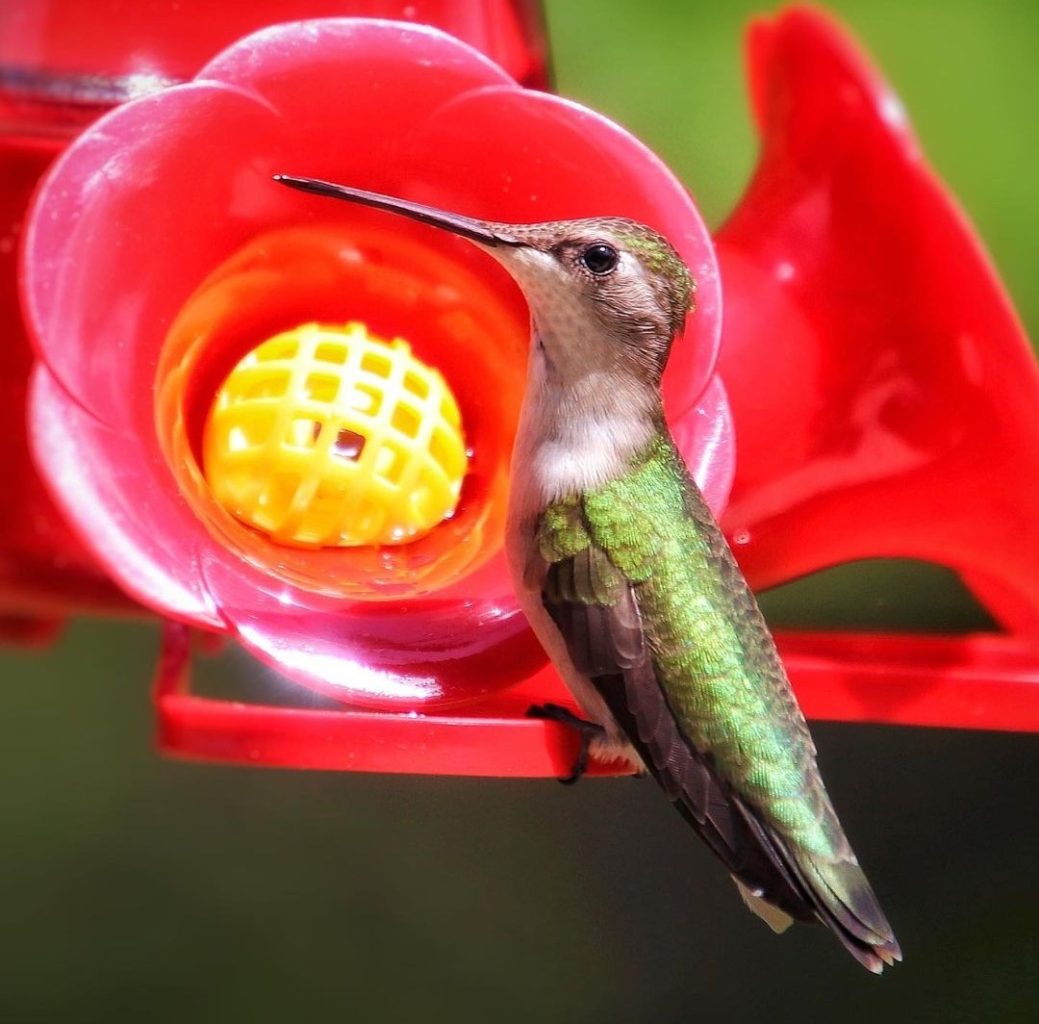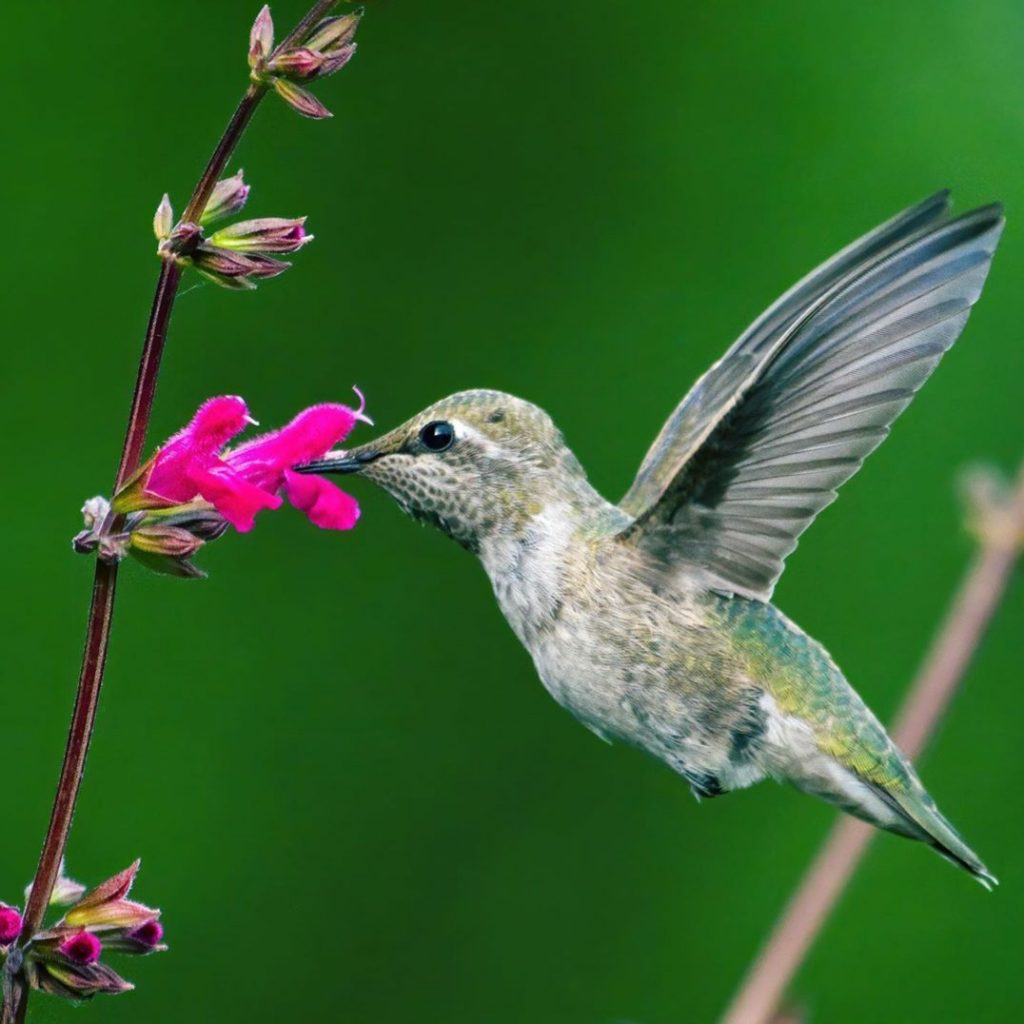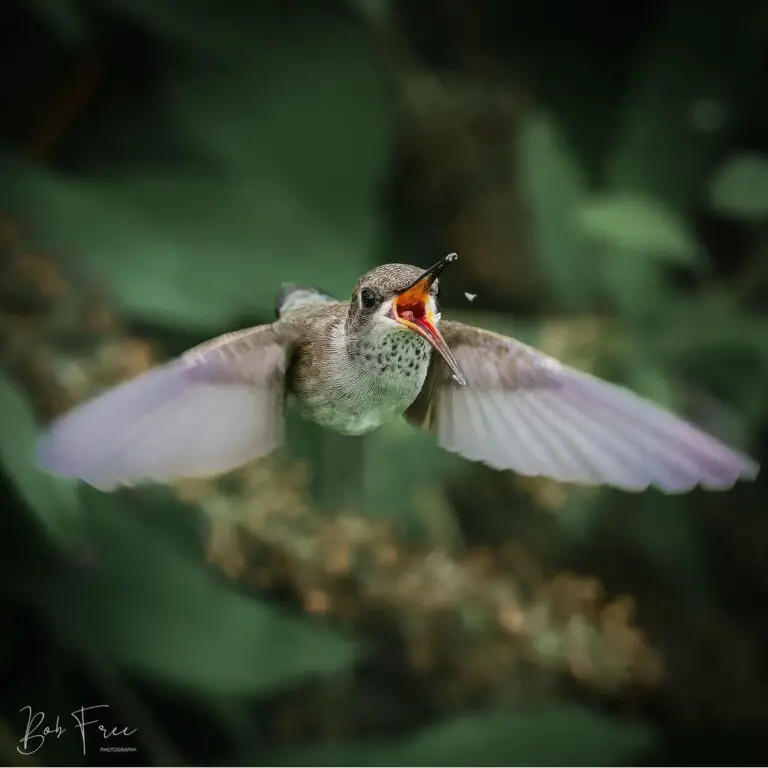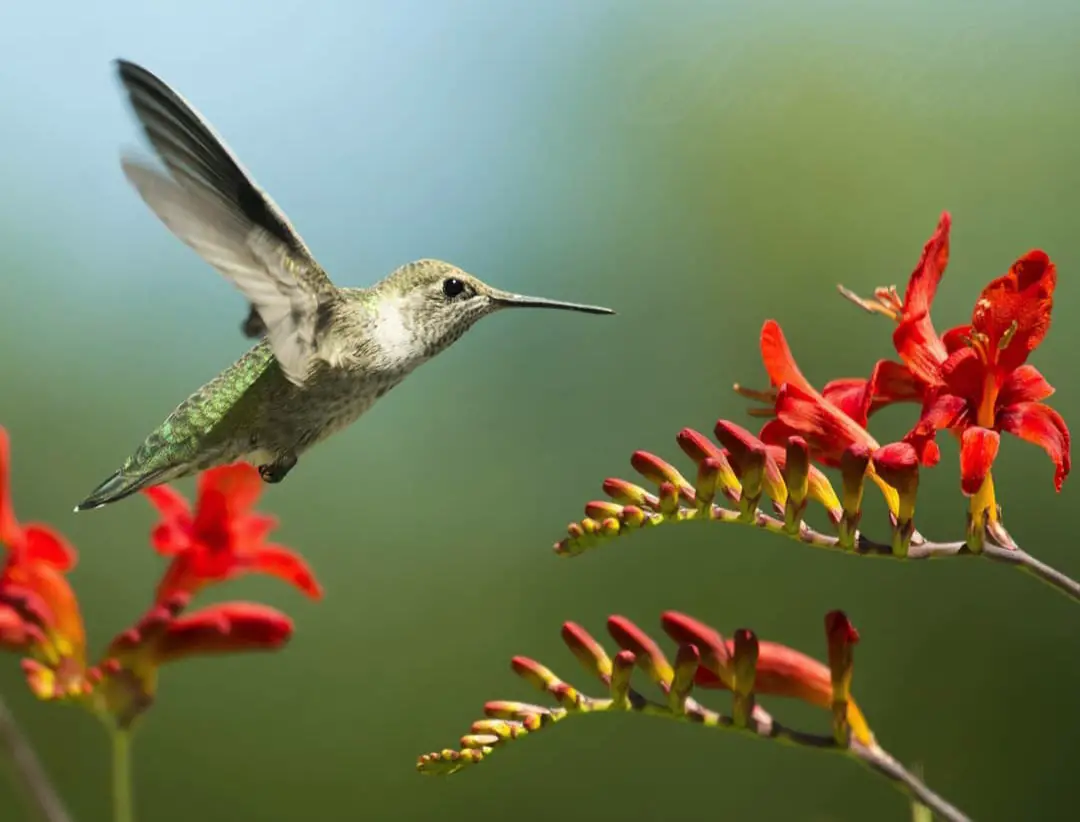This post contains affiliate links.
While I was watching many of my hummingbirds fill their bellies just before nightfall, I was wondering how I could help them find the food they needed other than sugar water and further wondered what food that would be.
This article is an in-depth discussion of what foods hummingbirds eat and how hummingbird enthusiasts can help provide those foods.
What Do Hummingbirds Eat?
For energy, hummingbirds consume nectar from flowers and feeders, and for the proteins and fats required for regenerating bodily tissues and reproduction, they eat insects and spiders.
Hummingbirds possess an exceptionally high metabolic rate, necessitating a near-constant intake of nectar for energy. Nectar makes up about 70% of their total caloric intake. This consists of nectar obtained from flowers and specialized feeders.


In addition to nectar, these avian species also consume small arthropods and insects such as fruit flies, ants, aphids, gnats, and mosquitoes for their protein and fat needs as well as for body tissue repair and maintenance.

To sustain their energy demands, hummingbirds feed at brief intervals, typically every 10 to 15 minutes, while daily visiting a substantial number of flowers. This contributes to their ecological significance as pollinators.
This remarkable dietary behavior underscores the appeal of hosting hummingbirds within one’s garden or natural habitat.
Prior to a long non-feeding migratory journey, hummingbirds consume an enormous amount of nectar and increase their body weight, up to 50% of which is stored as fat.
Hummingbird migratory routes across the Gulf of Mexico, which require 20 hours or longer of nonstop flight, serve as evidence that they can go for longer than 24 hours without nectar.
Do Hummingbirds Eat Only Sugar Water?
Hummingbirds require more than just sugar water and flower nectar to survive. For a balanced diet, hummingbirds consume nectar and also eat insects and arthropods for essential nutrients, proteins, and fats.
Hummingbirds do not solely live on and eat sugar water alone. Their dietary spectrum is fortified by protein-rich insects and minuscule arachnids.
One interesting product to consider is the Humm-Bug Protein Feeder. It is designed to attract and provide fruit flies, which are a protein-rich food source for hummingbirds.
Another way of providing insects for hummingbirds is to have an insect-attracting compost bin in your backyard.
It is important to recognize that in the wild, hummingbirds continue to forage for insects and spiders to maintain a balanced nutritional diet.
Do Hummingbirds Eat Bugs?
Hummingbirds eat a variety of bugs, including insects and spiders, as a source of protein, which is essential for the repair and maintenance of body tissue and reproductive building blocks for procreation.
Hummingbirds do eat insects and spiders in addition to nectar from flowers. While nectar is their primary source of food and provides them with the energy they need for their high metabolism and rapid wing beats, insects and spiders offer essential protein.
Hummingbirds catch insects and spiders by darting and hovering near foliage or in the air, using their long bills to snatch prey from leaves, spider webs, or even in mid-flight.
This insectivorous behavior is especially important during the breeding season when they require more protein for egg production and feeding their chicks.
Hummingbirds primarily consume small insects and arachnids, such as:
- Midges: These small, flying insects are a common food source for hummingbirds.
- Flies: These can include fruit flies, gnats, and small flying insects.
- Spiders: Hummingbirds are known to pick spiders off webs or capture them in mid-air.
- Aphids: These tiny plant-sucking insects are sometimes found on flowers. Hummingbirds may feed on them when they come into contact with nectar.
- Ants: While not a primary food source, hummingbirds may consume ants if they are on or around flowers.
- Mosquitoes: Hummingbirds may catch and eat mosquitoes when they encounter them.
Hummingbirds rely on insects and spiders mainly as a source of essential proteins and fats.
Do Hummingbirds Eat Insects?
Hummingbirds eat insects as an essential source of proteins and fats necessary for body tissue maintenance and egg production. Insects also provide vital minerals for the hummingbird.
Hummingbirds do consume insects, but nectar from flowers makes up the majority of their diet.
Additionally, hummingbirds need protein and fat in their meals. These proteins and fats are obtained from insects. Hummingbirds are opportunistic feeders and they use their quick, accurate beaks to grab insects as they fly by or pick them off leaves and spider webs.
For hummingbirds, proteins and fats from insects are essential, especially during the breeding season when they require more energy to raise their young. While nectar makes up the majority of their diet, insects are crucial for giving them the nutrients they need to sustain both their overall health and reproduction.
Do Hummingbirds Eat Mosquitoes?
Hummingbirds eat mosquitoes when scavenging and foraging for food; however, mosquitoes are not a primary insect resource. Insects are a valuable part of their diet, providing essential protein and fats.
Insect consumption by hummingbirds provides essential proteins and fats, especially during the breeding season when they require more protein for egg development and feeding their young.
However, mosquitoes are not a primary or preferred source of insects for hummingbirds. They are more likely to feed on other types of small flying insects.
Do Hummingbirds Eat Spiders?
Hummingbirds do eat spiders as a source of protein and fat. Spiders provide essential nutrients in a hummingbird’s diet for its health and reproductive needs.
Spiders are not a hummingbird’s main food source; however, they are a valuable supplement to their diet, growth, and reproduction.
During the breeding season, hummingbirds require more proteins and fats to raise their young.
Hummingbirds are agile flyers and can catch insects, including spiders, in mid-air or by plucking them from spider webs. They may also glean spiders from plants or other surfaces.
Hummingbirds must be cautious about not becoming entangled in a spider’s web less they become the prey instead of the predator.
Do Hummingbirds Eat Flies?
Hummingbirds eat flies for protein and fat that are necessary for tissue growth, maintenance, and reproductive needs. Flies include fruit flies, gnats, and other small flying insects.
Hummingbirds eat all types of flies, including fruit flies, gnats, midges, houseflies, mosquitoes, hoverflies, robber flies, and other small flying insects.

Hummingbirds are agile flyers and can catch insects in mid-air or pluck them from vegetation when the opportunity arises.
Insects provide essential proteins, fats, and nutrients that help hummingbirds meet their dietary needs, especially during the breeding season when they require extra tissue building blocks.
Do Hummingbirds Eat Ants?
Hummingbirds occasionally eat ants while foraging for proteins and fats, but they avoid Formic Ants or any nectar source with a formic acid scent.
Though not a regular part of their diet, hummingbirds have occasionally been seen eating ants.
Sometimes hummingbirds may inadvertently ingest ants while feeding on nectar or catching insects, but they are not known to seek out ants as a significant food source.
Even though the majority of ants are not formic, formic ants leave behind aromas that deter hummingbirds from feeding on them or anything around where they have left their scent.
See my article: Can Hummingbirds Detect Scents: A Complete Guide
Do Hummingbirds Eat Grape Jelly?
Hummingbirds consume all their carbohydrate needs in a liquid form therefore they would not attempt to eat grape jelly.
Grape jelly is not eaten by hummingbirds but is used to feed Orioles. Hummingbirds prefer nectar from flowers and feeders, as well as insects and spiders, for a well-balanced diet.
Although controversial, some hummingbird enthusiasts have reported hummingbirds drinking the juice of cut fruits.
Do Hummingbirds Eat Bananas?
Hummingbirds do not eat bananas but are attracted to and eat the fruit flies surrounding over-ripe bananas.
Providing a ripe banana lures fruit flies, providing a continuous protein-rich food source for hummingbirds.
One interesting product to consider is the Humm-Bug Protein Feeder. It is designed to attract and provide fruit flies, which are a protein-rich food source for hummingbirds.
Adding a Humm-Bug feeder to attract hummingbirds to your backyard is a great idea.
Do Hummingbirds Eat Apples?
Hummingbirds consume all their carbohydrate needs in a liquid form therefore they would not attempt to eat an apple. They are after the fruit flies attracted to the decomposed apple.
A ripe apple attracts fruit flies, giving hummingbirds a consistent source of protein-rich food.
Adding a Humm-Bug protein feeder to entice hummingbirds to your backyard is a great idea.
Do Hummingbirds Eat Bird Seed?
Hummingbirds do not eat bird seed because their specialized beaks are adapted for sipping nectar, not cracking and opening seeds. They primarily feed on flower nectar or feeders for energy and eat insects for protein and fat.
How Often Do Hummingbirds Need to Eat?
Hummingbirds can go without food for 24 hours during long migration flights and throughout the entire night during torpor, but during non-migratory daylight hours, they prefer to feed every 10-15 minutes.
Hummingbirds, due to their high metabolism, prefer to feed every 10-15 minutes during the day from dawn until dusk, visiting a multitude of flowers. At night they enter a state of torpor to conserve energy.
See my article: Hummingbird Slumber: The Secret to Conserving Energy at Night
Hummingbirds are able to fly non-stop across the Gulf of Mexico for 20 hours during migration, proving that they can spend up to 24 hours without nourishment.
Every day, hummingbirds consume almost half of their body weight in food. On average, hummingbirds will visit anywhere from 1,000 to 2,000 flowers in a single day.
They use their long, specialized bills and tongues to sip nectar from deep within their favored red tubular flowers.
In addition to nectar, hummingbirds catch and eat insects and spiders for protein and fat. On average, a hummingbird consumes hundreds of tiny insects daily to meet its protein and fat requirements. These insects include ants, aphids, fruit flies, gnats, mosquitoes, and midges.
To attract flying insects, try the Humm-Bug Protein Feeder.
This diet provides them with the necessary nutrition and energy they need for their daily activities, such as hovering, rapid flight, courtship displays, and territorial activities.
Hummingbirds busily forage for food during the day and at night they go into a state of torpor, which is a deep hibernation-like sleep that allows them to conserve energy. Their metabolic rate decreases significantly, allowing them to survive throughout the night without having to eat.
Hummingbirds must refuel as soon as they wake up from torpor in the morning to replenish their energy reserves.
They will consume 25% of their total carbohydrate intake for the entire day in the first few minutes after awakening from torpor.
Hummingbirds are also essential pollinators for many plants. Offer them a constant supply of nectar through gardens filled with nectar-rich flowers. Maintain a steady supply of nectar sources through flowers, supplemental feeders, and insect-rich environments to support their well-being and satisfy their high-energy lifestyles.
What to Feed Hummingbirds?
Feed hummingbirds homemade nectar of white granulated sugar water for energy and attract flying insects to provide the proteins and fats they need for tissue regeneration and procreation. Attract the flying insects using overripened fruit.
Feeding hummingbirds with a mixture of homemade sugar water and providing insect-rich environments and garden landscapes that produce sweet nectar flowering plants will assist with hummingbird survival.
Below is an outline of what to feed hummingbirds:
Homemade Sugar Water
A mixture of sugar-to-water, 1:4 ratio, mimicking the natural sugar concentration found in flower nectar, is used in hummingbird feeders to feed hummingbirds.
To make hummingbird nectar, heat water (boiling is optional).
Stir in the sugar (1/4 cup per 1 cup of water, or 1 cup per 1 quart of water).
Let it cool to room temperature.
Do not use red dye, honey, brown sugar, or unprocessed sugars, as they will harm hummingbirds.
Hummingbird feeders incorporate the color red to catch the hummingbird’s attention without using harmful chemicals. The red feeder color mimics their natural flower preferences.
Feeder selection, maintenance, and placement are key components to successfully feeding hummingbirds.
Keep your hummingbird feeders clean to prevent mold and bacterial growth.
Hang the feeder in a location that is easily visible but also provides some shade to prevent the sugar water from fermenting.
For more in-depth information on making homemade hummingbird nectar, see my article:
Hummingbird Sugar Water: A Complete DIY Step-By-Step Guide
Attract Insects
Every day hummingbirds eat a variety of insects and arachnids for essential proteins and fats.
Ants, aphids, fruit flies, gnats, mosquitoes, and midges are some of the insects that they consume.
The quantity of insects hummingbirds ingest is based on the size of the hummingbird, the number of insects present in their habitat, and personal dietary choices.
Fruit flies are a popular source of protein for hummingbirds.
Placing overripe bananas near a hummingbird feeder lures fruit flies, subsequently enticing the hummingbirds.
A way to attract insects is with a Humm-Bug Protein Feeder designed to present overripe fruit and attract these flying insects.
Also, creating compost with leftover table scraps and grass clippings will result in decaying organic matter, producing an abundance of flying insects, and being environmentally friendly at the same time.
Encourage insects to your garden while avoiding pesticides, which are harmful to hummingbirds and the environment.
Plant Hummingbird Friendly Flowers
Create a hummingbird eco-friendly landscape filled with a variety of their favorite diverse nectar-rich flowers.
Some popular hummingbird-friendly flowers include bee balm, trumpet vine, salvia, and fuchsia.
Hummingbirds prefer vibrant tubular flowers of red, pink, or purple that hold the most nectar.
See my article: Increase Backyard Hummingbird Activity in 7 Days or Less
When creating a hummingbird-friendly garden, consider planting a mix of these flowers to provide nectar throughout the growing season.
Additionally, maintain a pesticide-free environment to protect both the hummingbirds, the insects, and the environment.
Create a well-balanced nutritional environment by providing these precious hummingbirds with sugar water nectar for energy and insects for proteins and fats.
See my article: Hummingbird Diet: From Nectar to Insects
What Should Hummingbirds Not Eat?
Hummingbirds should not be fed artificial sweeteners, honey, red dye, spoiled nectar, insects treated with pesticides, fruits, alcohol, milk or dairy products, breads of any kind, or nectar substitutes.
Artificial Sweeteners: Hummingbirds rely on natural sugars found in flower nectar for energy. Artificial sweeteners can be harmful to them and provide no nutritional value.
Honey: Hummingbirds consume nectar and do not naturally feed on honey. Honey can ferment and promote the growth of harmful bacteria in their digestive systems.
Red Dye: Some commercial hummingbird nectar mixes contain red food dye to attract hummingbirds. However, these dyes can be harmful and are unnecessary. It is best to provide clear or naturally colored nectar.
Spoiled Nectar: Nectar should be fresh and free of mold or fermentation. If the nectar in your feeder turns cloudy or smells off, it should be replaced immediately.
Insects Treated with Pesticides: Hummingbirds also eat insects for protein. Insects treated with pesticides can be toxic to hummingbirds if ingested.
Fruits: Hummingbirds primarily feed on nectar; they are not fruit-eating birds.
Feeding them fruits may not provide the proper nutrition and can lead to digestive issues.
Alcohol: Some people mistakenly believe that hummingbirds are attracted to alcoholic beverages. Alcohol is toxic to hummingbirds and should never be offered to them.
Milk or Dairy Products: Hummingbirds are lactose intolerant and cannot digest dairy products. Feeding them milk or other dairy items can lead to digestive problems.
Bread: Bread has no nutritional value for hummingbirds and can swell in their stomachs, causing harm. It is not food suitable for them.
Nectar Substitutes: It is best to make your own nectar with the correct sugar-to-water ratio.
See my article: Hummingbird Sugar Water: A Complete DIY Step-By-Step Guide
To attract and provide for hummingbirds, it is essential to offer them fresh, clean nectar in appropriate feeders and maintain a safe and natural environment for them to forage for insects and nectar in your garden.
Check out my other posts on Hummingbird Questions
Happy Hummingbird Feeding!
Backyard Visitors participates in affiliate programs which compensate us for referring traffic.


